Managing Cross-Contamination at Home
How to prevent accidental gluten exposure in your kitchen and home



Fast Facts:
⚡ Communication is key - Talk to housemates about cross-contamination risks
⚡ Create a gluten free safe space - Dedicate certain cupboards, shelves, and prep areas
⚡ Be mindful of shared appliances - Ovens, air fryers, toasters and microwaves can all transfer gluten
⚡ Label everything - Use stickers or a label maker to mark gluten free products and prevent mix ups
⚡ Avoid cross-contamination with utensils and food prep
⚡ Clean thoroughly - Wipe down surfaces, wash hands often, and follow proper cleaning methods for appliances
⚡ Use common sense - If something seems risky, it probably is! When in doubt, take extra precautions
⚠️ Cross-Contamination in the Kitchen
For most people following a gluten free diet, sharing a kitchen is the norm - whether that's with family, a partner, housemates, or at uni. Understanding cross-contamination risks and how to navigate a shared space is key, especially when not everything in the kitchen is gluten free.
It can feel overwhelming at first, but managing a shared kitchen is completely doable without needing an entirely separate space. It just takes communication, a few new habits, and a clear understanding of what cross-contamination looks like.
The truth is that adjusting to this new lifestyle can take time. You might not feel comfortable right away, and that's okay. But by talking to the people you live with, explaining what being gluten free means to you, and agreeing on how to keep your food safe, it becomes much easier.
The most important first step? Talk about it. Explain what coeliac disease or non-coeliac gluten sensitivity actually means for your health, what happens if you eat gluten, and how cross-contamination works. Most people will want to support you once they understand - but they may make mistakes along the way. If it’s a genuine accident, talk about it and find a solution together. If someone’s not taking it seriously, you might need to set clearer kitchen rules or use separate cooking tools.
Key high-risk areas to focus on when managing cross-contamination:
- 🔥 Cooking - Ovens, air fryers, microwaves, toasters, BBQs
- 🔪 Utensils - Chopping boards, knives, trays, kitchen tools
- 🧈 Shared Food Products - Butter, condiments, snacks, oil
- 🗄️ Storage - Cupboards, fridge, counters
- 🧽 Cleaning - Hands, surfaces, washing up
🔥 Cooking
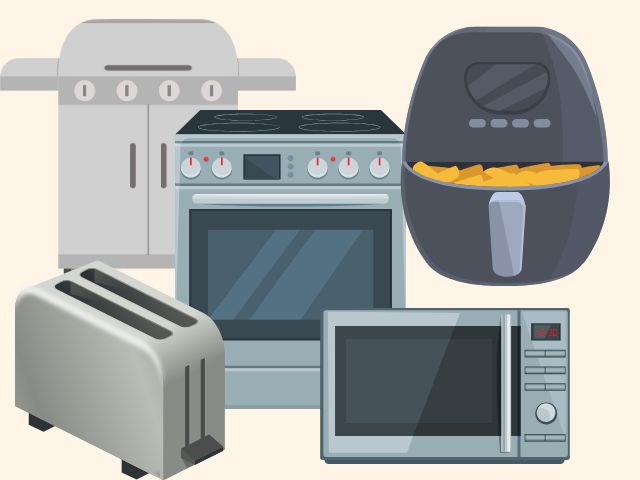
Oven
There is limited research on whether it is completely safe for gluten free individuals, particularly those with coeliac disease, to share an oven with gluten-containing foods. Since most households won’t have the space or budget for multiple ovens, managing cross-contamination effectively is key. Remember, high temperatures do not destroy gluten particles!
⚠️ Risk: Gluten crumbs or spills can fall onto oven racks, trays, and surfaces, making direct contact with gluten free food placed nearby - especially if gluten free food is positioned below gluten containing food. Hot air circulation can spread gluten particles, and airborne flour can linger and settle on gluten free food. These factors significantly increase the risk of cross-contamination
- Fan ovens (convection ovens) circulate hot air, which can spread gluten particles throughout the oven, increasing the risk of contamination if gluten free and gluten containing foods are cooked at the same time
- Conventional ovens (electric or gas ovens) do not circulate air as aggressively, but gluten residue from previous cooking can still be present on racks, trays, or walls
✅ Solution:
- Always cook gluten free food on top racks to prevent gluten containing crumbs from falling onto them
- Use baking trays for gluten free items rather than placing food directly on oven racks
- Avoid cooking flour-dusted items, flaky pastries or any food that could easily release gluten particles into the air at the same time as gluten free food
- Line trays or cover gluten free food with foil or parchment paper to create a protective barrier
- Keep the oven clean by wiping up spills and crumbs regularly
Air Fryer
There is also limited research on whether it is safe to share an air fryer between gluten free and gluten containing foods. Ideally, households would have a separate gluten free air fryer, but this is almost always impractical due to cost or space constraints. Instead, here are some key tips to minimise the risk of cross-contamination
⚠️ Risk: Like fan ovens, air fryers work by circulating hot air, which can spread gluten particles inside the fryer, contaminating gluten free food. Even if gluten containing foods were cooked previously, residue may remain and on the heating element, basket or interior walls
✅ Solution:
- Don't share baskets - if only one fryer is available, use separate baskets
- If using a duel-basket air fryer, designate one side strictly for gluten free cooking - but be aware that in some models, air may circulate throughout the entire appliance
- Avoid cooking flour-coated or breaded gluten containing foods in the air fryer if shared
- Thoroughly clean baskets and give everything a wipe down to remove any crumbs or residue after each use
- Follow manufacturer’s instructions on cleaning the heating element every so often, as gluten particles may become trapped there
Microwave
⚠️ Risk: Gluten containing food can splatter inside, contaminating the interior and other foods. Shared microwave covers can also harbour gluten
✅ Solution: Wipe it down regularly, use a dedicated gluten free cover or plate, and avoid placing gluten free food directly on the microwave plate
Toaster
⚠️ Risk: Toasters trap crumbs which you can’t easily clean, making it impossible to fully remove gluten contamination. Using the same toaster for gluten free and gluten containing bread is unsafe
✅ Solution: Use a separate toaster for gluten free bread, toaster bags or use the grill instead
BBQ
⚠️ Risk: Gluten-containing marinades, sauces, burgers, sausages or breaded buns can leave residue on the grill. Cross-contact from shared utensils is also a risk
✅ Solution: Use a separate section of the grill or a dedicated gluten free BBQ grill mat. Clean grill grates thoroughly before cooking gluten free items but if the space seems too cramped to safely cook gluten free food, it’s best to cook inside separately.
🔪 Utensils
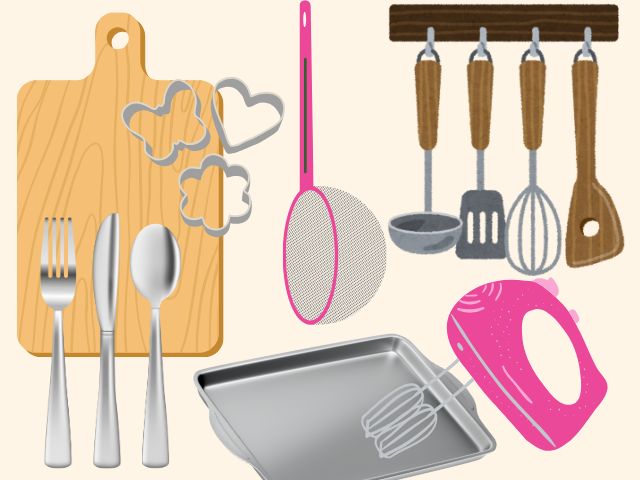
Chopping Boards
⚠️ Risk: Gluten particles can get trapped in grooves on wooden or plastic boards, even with washing, leading to cross contamination
✅ Solution: Use a separate gluten free chopping board, preferably a different colour, to avoid mix-ups or ensure that gluten is only used on a dedicated gluten board
Kitchen Tools (Spatulas, sieves, baking equipment etc.)
⚠️ Risk: Shared utensils and other kitchen products can transfer gluten from one food to another, especially with sticky or crumbly foods that get stuck in corners and crevices
✅ Solution: For anything that is difficult to clean, consider buying separate gluten free items or make sure to wash thoroughly before using such as sieves, whisks, griddle pans, rolling pins, cookie cutters
Oven Trays
⚠️ Risk: Gluten residue from previous use can remain on trays, especially burnt food and grease, even after washing by hand or in the dishwasher
✅ Solution: Use separate trays for gluten free cooking or line them with parchment paper or foil before use
Cutlery
✅ Good news: As long as it's thoroughly cleaned you won’t need to have separate cutlery - just watch out for rogue drawer crumbs - it's a mystery that always happens…
🧈 Shared Food Products
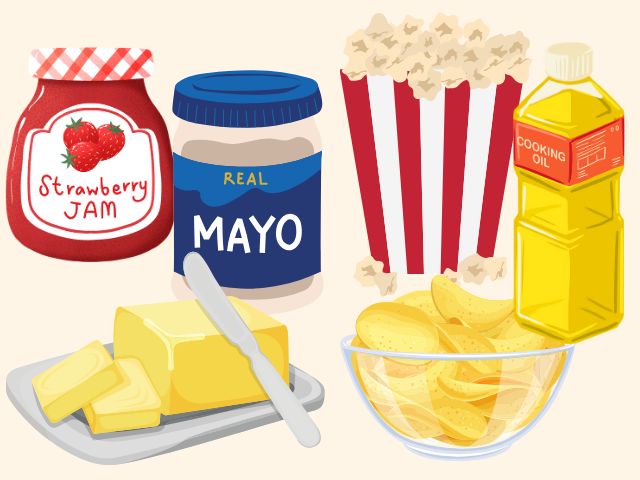
Butter
⚠️ Risk: Double-dipping with a knife used on gluten-containing items transfers crumbs into the butter, making it unsafe
✅ Solution: Use a separate gluten free butter container or pre-portion butter with a clean utensil and do not double-dip
Condiments
⚠️ Risk: Jars of condiments like mayonnaise, jam, and peanut butter can become contaminated if a used knife/spoon is dipped back in after touching gluten
✅ Solution: Use squeeze bottles for condiments whenever possible. If jars are the only option, have a gluten free-only version or ban double-dipping
Snacks
⚠️ Risk: Shared snack bowls e.g. popcorn, crisps etc. can be contaminated if someone with gluten-containing hands reaches in
✅ Solution: Keep gluten free snacks in sealed containers and avoid communal bowls - having your own bowl is better anyway!
Cooking Oil
⚠️ Risk: Cross-contamination from gluten food to gluten free products when cooked in the same oil
✅ Solution: Always use clean oil for gluten free foods, do not reuse oil previously used for gluten containing products
🗄️ Storage
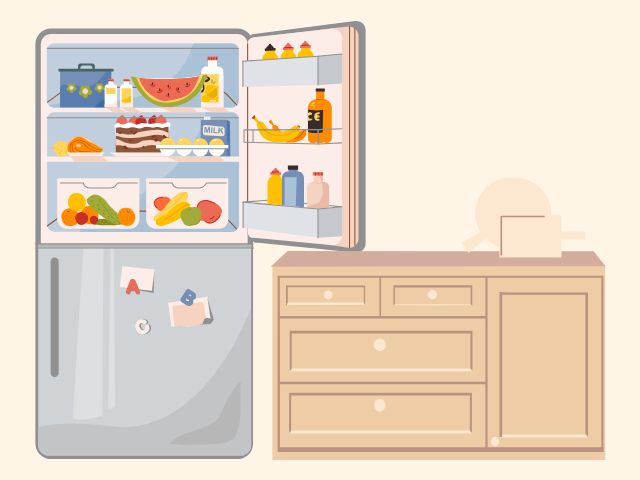
Separate Cupboards
⚠️ Risk: If gluten containing and gluten free items are stored together, accidental mix-ups can happen or gluten can find its way onto gluten free food
✅ Solution: Store gluten free food separate to gluten containing food, ideally in different cupboards or in sealed containers. Depending on your situation, consider having a dedicated gluten cupboard instead of a gluten free one - then the risk is contained in one space rather than the whole kitchen
Fridge
⚠️ Risk: Gluten containing food can spill or drip onto gluten free items
✅ Solution: Store gluten free items on the top shelf to prevent drips, label gluten free foods clearly and keep them in separate containers
Counters
⚠️ Risk: Gluten containing crumbs or flour dust can settle on countertops, contaminating any gluten free left out on counter tops
✅ Solution: Store gluten free food in a cupboard, ideally in some sort of packaging or containing to limit any cross-contamination risks
🧽 Cleaning
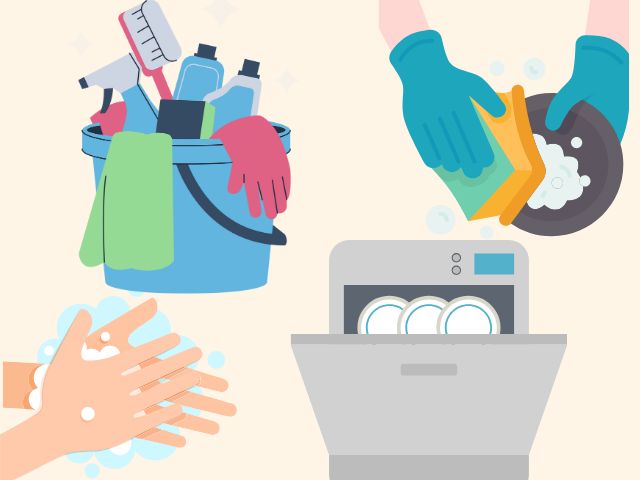
Hand Hygiene
⚠️ Risk: If someone handles gluten-containing food and then touches gluten free items, cross-contamination can occur
✅ Solution: Wash hands thoroughly before preparing gluten free food or get into the habit of washing hands after touching gluten containing food
Cleaning Surfaces
⚠️ Risk: Gluten crumbs and spills can linger on surfaces
✅ Solution: Regularly keep on top of the kitchen and clean surfaces with hot soapy water or a cleaning spray. Depending on your set up, have a dedicated gluten prep area to keep cross-contamination to a minimum in one space
Washing Up
✅ Good news: There’s no need for separate clothes or sponges but thoroughly wash all kitchen and tableware with washing up liquid to remove gluten residue. Using a dishwasher will also remove gluten particles
⛑️ Extra Tips
⭐ Label gluten free products - Stickers or a label maker help everyone know what's safe
⭐ Create a gluten-only cupboard & prep zone - Instead of designating a gluten free cupboard, condense gluten containing foods into one dedicated space, this keeps the majority of cupboards and surfaces gluten free, reducing the risk of contamination
⭐ Serve gluten free food first - This is especially important for self-serve meals where multiple people are handling food - letting the gluten free person serve themselves first helps keep their meal safe
⭐ Cook gluten free for everyone - Whenever possible, cook meals that are naturally gluten free for everyone:
- Reduces cross-contamination risks
- Simplifies meal prep (no need for separate ingredients)
- Prevents accidental mix-ups (e.g. using gluten free stock cubes, flour and sauces)
- More inclusive
🤩 Need inspiration? Check out our recipe section for HUNDREDS of gluten free recipes at your fingertips!
⭐ Use Common Sense - If something feels risky, it probably is. Trust your gut (literally!)
🎯 Quick Recap:
Communication comes first - Talk openly with housemates or family, help them understand why cross-contamination matters
Designate key areas - Separate tools, boards, shelves, and storage
Clean as you go - Hands, surfaces, trays - everything!
Label your stuff - Clear labels = fewer mistakes
Be mindful with appliances - Especially toasters, ovens, and air fryers
Avoid communal dips - Have your own butter, condiments, and snacks
Serve gluten free first - Reduces contamination at meal times
Trust your instincts - Use common sense, and don’t be afraid to speak up
Learning how to manage gluten safely is a process - but once you’ve got your systems in place, it becomes second nature. Whether you’re coeliac or supporting someone who is, it’s all about understanding the risks, working together, and creating a safe space where everyone can feel confident and cared for.
Of course, there are no limitations on how far you want to go to ensure a completely gluten free kitchen - if you want to build a second kitchen, duplicate appliances and buy everything brand new, don’t let us stop you. But, the reality is that learning how to manage gluten safely is a more practical and realistic solution. By understanding cross-contamination risks and setting up clear kitchen rules, you can stay as safe as possible while sharing space with others.